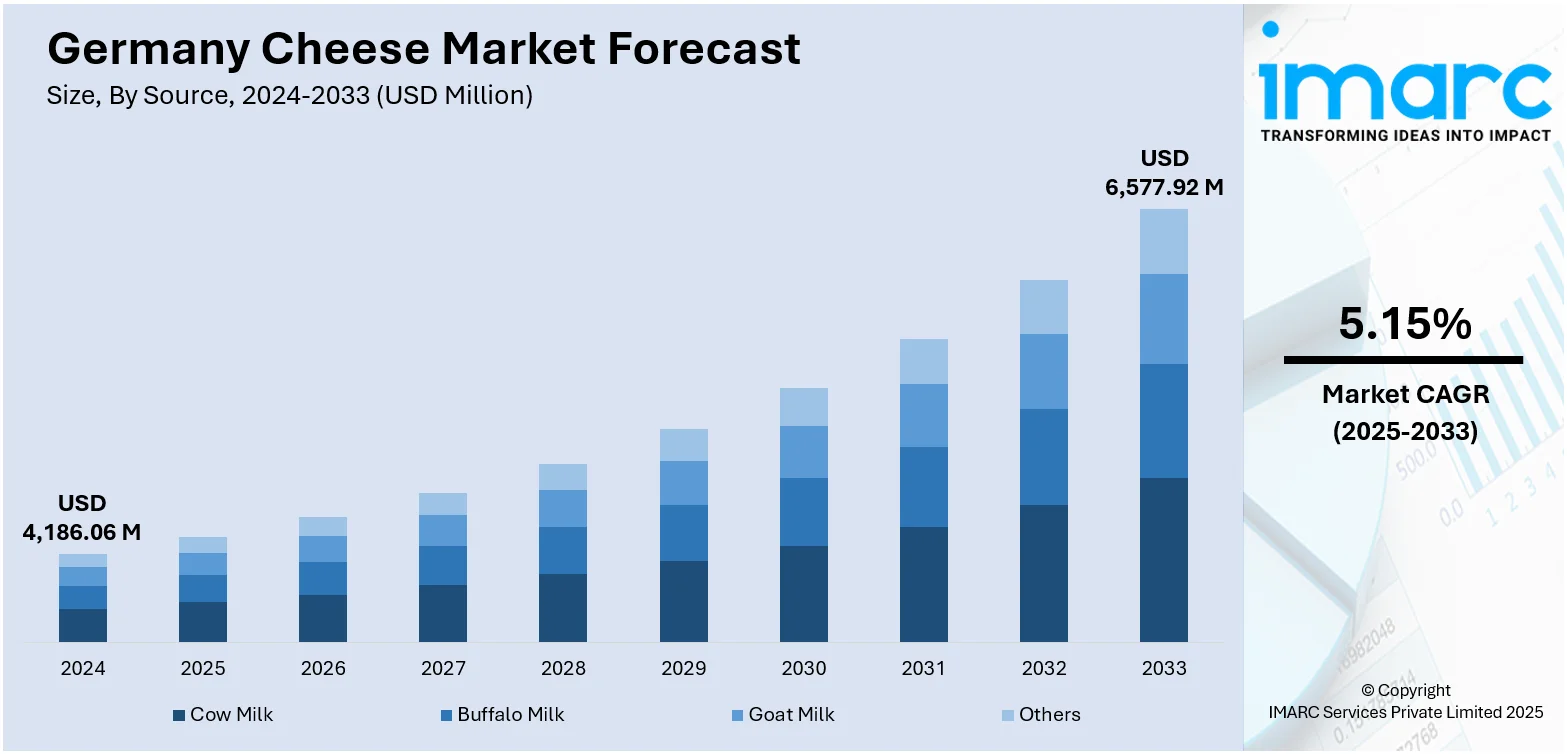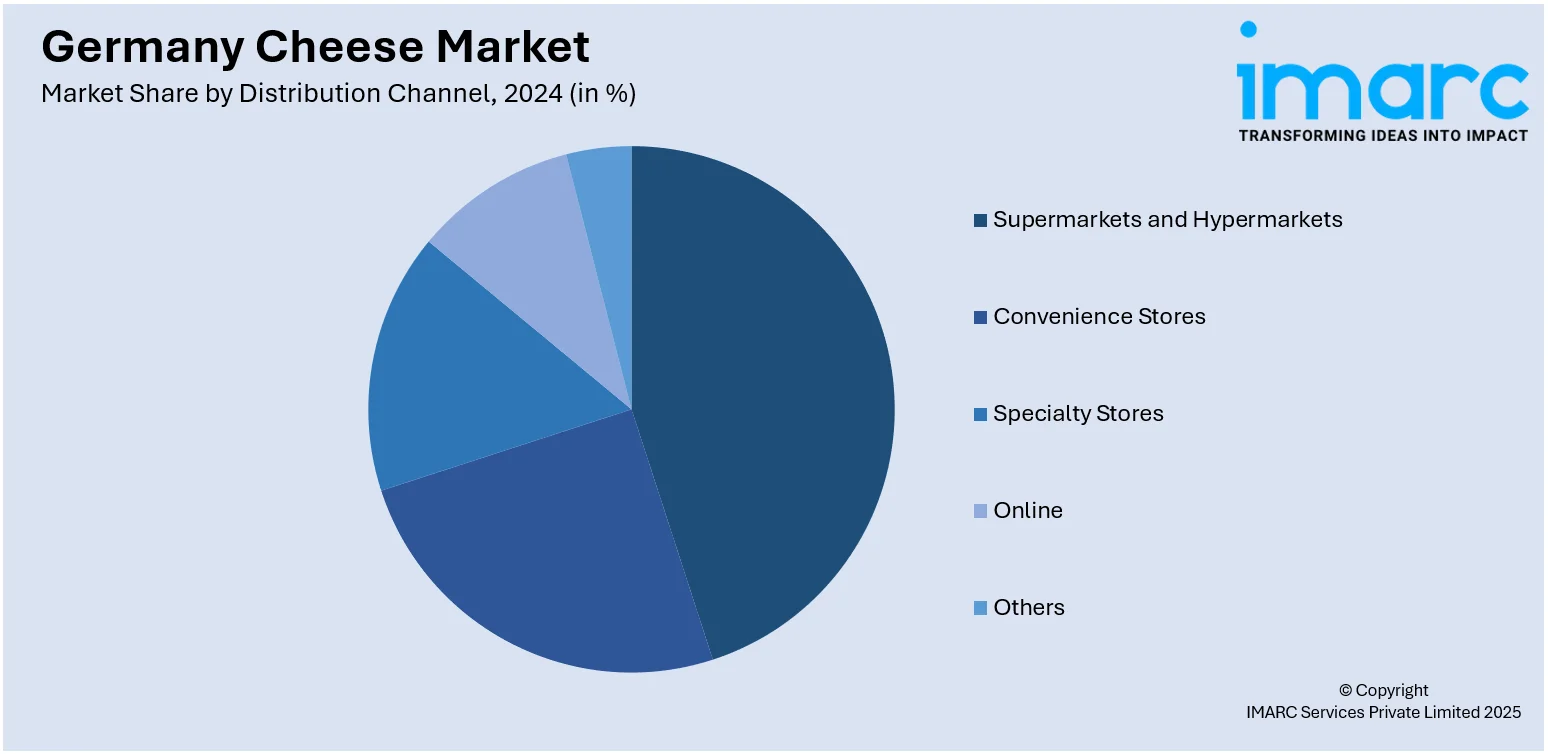
Germany Cheese Market Size, Share, Trends and Forecast by Source, Type, Product, Format, Distribution Channel, and Region, 2025-2033
Germany Cheese Market Overview:
The Germany cheese market size reached USD 4,186.06 Million in 2024. The market is projected to reach USD 6,577.92 Million by 2033, exhibiting a growth rate (CAGR) of 5.15% during 2025-2033. The market is fueled by changing consumer lifestyles, growing demand for local specialties, and a strengthening emphasis on health-focused choices. Artisanal and organic cheese varieties are in accelerating demand, backed by high domestic production and growing demand for quality and authenticity. The foodservice sector further increases cheese consumption through extensive culinary use across casual and upscale dining categories. Through a strong dairy industry base and ongoing format innovation in products, these factors support the growth of the Germany cheese market share.
|
Report Attribute
|
Key Statistics
|
|---|---|
|
Base Year
|
2024 |
|
Forecast Years
|
2025-2033
|
|
Historical Years
|
2019-2024
|
| Market Size in 2024 | USD 4,186.06 Million |
| Market Forecast in 2033 | USD 6,577.92 Million |
| Market Growth Rate 2025-2033 | 5.15% |
Germany Cheese Market Trends:
Move Towards Artisanal and Local Cheese Types
Germany's cheese market is observing a consistent move towards artisanal and locally sourced cheese, as there is an increased consumer demand for local authenticity, traceability, and handcraft. Customers highly look for products with geographical identity and respect traditional practices, like raw-milk cheeses, mountain cheeses, and ones aged in small-dairy operations. Bavaria, Baden-Württemberg, and other states in the south are most emphasized with this trend because cheese-making is an integral part of local food culture. Farmers' markets, organic food shops, and specialty stores are widening their inventories with greater numbers of more local varieties bearing the Protected Designation of Origin (PDO) labels. Consumers' general trend toward patronizing sustainable agriculture and reducing transportation footprints also supports this shift. This, consequently, underlies Germany cheese market growth with the return of traditional local cheese-making and the high demand for distinctive, high-quality dairy experiences, which is a central support in the new domestic consumption dynamics.

To get more information on this market, Request Sample
Growing Demand for Health-Focused Cheese Products
The German cheese market is answering heightened consumer health awareness by growing the low-fat, lactose-free, and high-protein categories. As dietary consciousness has gone mainstream, cheese is no longer considered an old-fashioned luxury but is increasingly being included in functional diets. Buyers are choosing products with added nutritional value in terms of calcium, probiotics, and lower sodium levels to fit into health objectives without sacrificing taste or convenience. The growth of plant-based diets has also given rise to boost in demand for dairy-free and vegan cheese products among younger and urban consumers. As per the sources, in September 2024, Berlin-based Formo raised $61 million and rolled out koji-based cheese alternatives such as Frischhain and Camembritz to 2,000 REWE, BILLA, and METRO stores in Germany and Austria. Moreover, consumers and foodservice operators are adjusting to these changing tastes by expanding product ranges and promoting nutritional value. These changes mirror wider Germany cheese market trends, in which health-led innovation is instrumental in driving consumer behavior. The trend not only increases accessibility but also supports the use of cheese in an era of nutrition-conscious and lifestyle-driven society.
Increasing Usage of Cheese in Foodservice Channels
Germany's dynamic foodservice sector is playing an important role in amplifying demand for cheese as it emerges as a versatile and staple component in native and foreign cuisines. With an increase in dining out, especially in urban areas such as Berlin, Hamburg, and Munich, consumption of cheese is spreading beyond the home. Restaurants, cafes, and fast-food chains intensely incorporate cheese in its many applications, ranging from sandwiches and pizzas to gourmet platters and vegetarian meals. The increasing demand for international culinary experience also fuels usage of varied cheeses such as soft-ripened, blue, and semi-hard cheeses. Seasonal menus, chef-inspired innovation, and customers' demands for quality propelled premium and specialty cheese growth to record levels. Pointing to Germany cheese market trends, the changing foodservice environment supports rising consumer exposure to cheese and maintains steady volume growth for domestic and hospitality-driven channels.
Germany Cheese Market Segmentation:
IMARC Group provides an analysis of the key trends in each segment of the market, along with forecasts at the country and regional levels for 2025-2033. Our report has categorized the market based on source, type, product, format, and distribution channel.
Source Insights:
- Cow Milk
- Buffalo Milk
- Goat Milk
- Others
The report has provided a detailed breakup and analysis of the market based on the source. This includes cow milk, buffalo milk, goat milk, and others.
Type Insights:
- Natural
- Processed
A detailed breakup and analysis of the market based on the type have also been provided in the report. This includes natural and processed.
Product Insights:
- Mozzarella
- Cheddar
- Feta
- Parmesan
- Roquefort
- Others
The report has provided a detailed breakup and analysis of the market based on the product. This includes mozzarella, cheddar, feta, parmesan, roquefort, and others.
Format Insights:
- Slices
- Diced/Cubes
- Shredded
- Blocks
- Spreads
- Liquid
- Others
A detailed breakup and analysis of the market based on the format have also been provided in the report. This includes slices, diced/cubes, shredded, blocks, spreads, liquid, and others.
Distribution Channel Insights:

- Supermarkets and Hypermarkets
- Convenience Stores
- Specialty Stores
- Online
- Others
The report has provided a detailed breakup and analysis of the market based on the distribution channel. This includes supermarkets and hypermarkets, convenience stores, specialty stores, online, and others.
Regional Insights:
- Western Germany
- Southern Germany
- Eastern Germany
- Northern Germany
The report has also provided a comprehensive analysis of all the major regional markets, which include Western Germany, Southern Germany, Eastern Germany, and Northern Germany.
Competitive Landscape:
The market research report has also provided a comprehensive analysis of the competitive landscape. Competitive analysis such as market structure, key player positioning, top winning strategies, competitive dashboard, and company evaluation quadrant has been covered in the report. Also, detailed profiles of all major companies have been provided.
Germany Cheese Market News:
- In September 2024, METRO Germany introduced Frischain, an animal-free cream cheese produced by Formo with koji-based microfermentation. Supplied in 1.5 kg catering pack sizes, it's stocked in 102 METRO locations and 11 depots to meet the growing trend for sustainable, plant-based cheese alternatives in Germany's professional foodservice market.
- In May 2025, Schwarzwaldmilch entered into a strategic cheese manufacturing partnership with Käserei Bauhofer, concentrating on sales, marketing, and product innovation. Bauhofer will manufacture Schwarzwaldmilch's Black Forest range of cheese, both firms' regional output increasing and supporting innovation in Germany's changing dairy and cheese sector.
Germany Cheese Market Report Coverage:
| Report Features | Details |
|---|---|
| Base Year of the Analysis | 2024 |
| Historical Period | 2019-2024 |
| Forecast Period | 2025-2033 |
| Units | Million USD |
| Scope of the Report |
Exploration of Historical Trends and Market Outlook, Industry Catalysts and Challenges, Segment-Wise Historical and Future Market Assessment:
|
| Sources Covered | Cow Milk, Buffalo Milk, Goat Milk, Others |
| Types Covered | Natural, Processed |
| Products Covered | Mozzarella, Cheddar, Feta, Parmesan, Roquefort, Others |
| Formats Covered | Slices, Diced/Cubes, Shredded, Blocks, Spreads, Liquid, Others |
| Distribution Channels Covered | Supermarkets and Hypermarkets, Convenience Stores, Specialty Stores, Online, Others |
| Regions Covered | Western Germany, Southern Germany, Eastern Germany, Northern Germany |
| Customization Scope | 10% Free Customization |
| Post-Sale Analyst Support | 10-12 Weeks |
| Delivery Format | PDF and Excel through Email (We can also provide the editable version of the report in PPT/Word format on special request) |
Key Questions Answered in This Report:
- How has the Germany cheese market performed so far and how will it perform in the coming years?
- What is the breakup of the Germany cheese market on the basis of source?
- What is the breakup of the Germany cheese market on the basis of type?
- What is the breakup of the Germany cheese market on the basis of product?
- What is the breakup of the Germany cheese market on the basis of format?
- What is the breakup of the Germany cheese market on the basis of distribution channel?
- What is the breakup of the Germany cheese market on the basis of region?
- What are the various stages in the value chain of the Germany cheese market?
- What are the key driving factors and challenges in the Germany cheese?
- What is the structure of the Germany cheese market and who are the key players?
- What is the degree of competition in the Germany cheese market?
Key Benefits for Stakeholders:
- IMARC’s industry report offers a comprehensive quantitative analysis of various market segments, historical and current market trends, market forecasts, and dynamics of the Germany cheese market from 2019-2033.
- The research report provides the latest information on the market drivers, challenges, and opportunities in the Germany cheese market.
- Porter's five forces analysis assist stakeholders in assessing the impact of new entrants, competitive rivalry, supplier power, buyer power, and the threat of substitution. It helps stakeholders to analyze the level of competition within the Germany cheese industry and its attractiveness.
- Competitive landscape allows stakeholders to understand their competitive environment and provides an insight into the current positions of key players in the market.
Need more help?
- Speak to our experienced analysts for insights on the current market scenarios.
- Include additional segments and countries to customize the report as per your requirement.
- Gain an unparalleled competitive advantage in your domain by understanding how to utilize the report and positively impacting your operations and revenue.
- For further assistance, please connect with our analysts.
 Request Customization
Request Customization
 Speak to an Analyst
Speak to an Analyst
 Request Brochure
Request Brochure
 Inquire Before Buying
Inquire Before Buying




.webp)




.webp)












